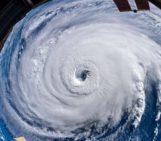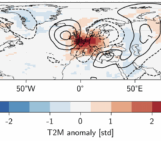
At the recent UNDERPIN2 conference (Understanding rare events and their climatic impacts, in Erice, Sicily), we held a discussion on the future of climate science. To guide the conversation, I ran an interactive survey to capture how climate scientists see the current challenges, opportunities, and blind spots in climate research, communication, and the use of artificial intelligence.
The responses—ranging from sharp critiques to hopeful suggestions—point towards a field in transition.
What Are We Missing?
When asked which types of extreme events are still poorly understood, respondents overwhelmingly pointed to tropical cyclones, convective events, and extreme precipitation.
Even after decades of scientific progress, these remain among the hardest to simulate and predict—especially when it comes to understanding the interaction between large-scale circulation patterns and local-scale drivers.
The most cited reasons for the lack of observational and modelling capacity in the Mediterranean region (the conference’s focus area) were conceptual and economic limitations, such as funding shortages, followed by political and technical barriers. This situation is way more challenging in the Global South, where data scarcity, infrastructure gaps, and resource constraints make progress even slower.
Impact Data
Understanding how climate extremes affect societies and ecosystems requires more than just modelling temperature or rainfall—it demands impact studies that connect physical climate data with real-world consequences. By impacts, we mean the effects of climate change on natural and human systems, including socioeconomic and ecological losses.
And yet, when it comes to impact data, one issue came up repeatedly: access.
Scientists explained that private ownership of data—for example, by companies or local authorities—often makes it difficult to obtain the detailed information needed to assess damages, economic losses, or other impacts.
Other recurring problems included the absence of long-term records and, in some cases, political restrictions that limit data sharing and transparency.
Without open, high-quality impact data, our ability to quantify risks, evaluate adaptation efforts, and bridge the gap between science and society remains limited.
Exploring the Role of AI in Climate Research
Artificial intelligence (AI) now appears in almost every scientific discussion, and climate research is no exception. When asked about the advantages of AI, participants highlighted its practical benefits in day-to-day work:
- Speeding up coding and administrative tasks
- Improving English and writing quality
- Supporting brainstorming and idea generation
Many scientists described AI as a helpful assistant—something that saves time, reduces repetitive work, and lets them focus on creative or analytical thinking.
But the enthusiasm was also mixed with caution. The most frequently mentioned disadvantages or downsides were the
- risk of errors
- loss of critical thinking, especially if researchers start relying too much on AI outputs
- quality of peer review
Others pointed to concerns about the ethical issues, the “black box” problem—where it’s not clear how an AI model reaches a result—and the environmental cost of large-scale computation.
When asked about risks, many voiced deeper worries: a potential loss of self-confidence and technical skills, the rise of uniform, formulaic writing, the danger of unconscious plagiarism, and even a loss of creativity and privacy.
Taken together, these views show a community that’s open to experimentation but also deeply aware that scientific integrity and interpretability must come first.
Policy and Communication
When it comes to engaging with society, most participants agreed that scientists should primarily act as advisors—providing evidence-based guidance for policy decisions. The second most popular role was communicator, helping the public understand complex findings. A smaller group felt scientists should take on a more activist role when the stakes are high.
On the question of climate change communication, I asked the participants to rank the main obstacles scientists perceive when trying to reach and engage the public on climate change, from most to least important:
- Polarized and politicized narratives
- Misinformation
- Information overload and message fatigue
- Lack of trust
- Absence of emotional connection or relatable stories
- Overuse of jargon and technical language
- Emphasis on problems rather than solutions
As for communication tone, most respondents suggested keeping messages realistic, neutral, clear, confident, and serious. A few felt that anger or fear can sometimes help convey urgency, while others emphasized the value of hope—as a way to inspire rather than overwhelm.
It’s interesting that these differing views all share one goal: finding better ways to connect scientific evidence with human experience.
If You Had $100 Million…
Finally, I asked a simple question: If you had $100 million to fund climate research, what would you prioritize?
The answers were as diverse as they were inspiring. Top ideas included topics such as building a European climate service, investing in climate adaptation research, enhancing observation networks, and optimizing climate models.
Final Thoughts
We’re missing data, process understanding, and stronger collaboration across disciplines, especially when it comes to quantifying the impacts of weather and climate extremes.
This survey—though small in scale—captures the current mood of the climate science community: a blend of frustration, realism, and cautious optimism. Scientists are well aware of the limits of their tools and the challenges of communicating uncertainty, yet they also recognize the transformative (and sometimes unsettling) potential of AI. Ultimately, the future of climate science will depend not only on technology but on how effectively we connect data, people, and purpose.





